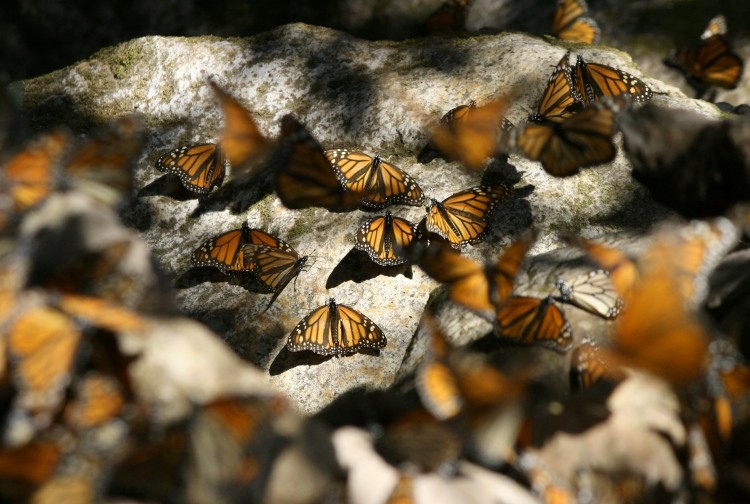By James Urton
Futurity
Each fall, monarch butterflies across Canada and the United States turn their colorful wings toward the Rio Grande and migrate more than 2,000 miles to the relative warmth of central Mexico.
The journey, repeated instinctively by generations of monarchs, continues even as their numbers have plummeted due to loss of their sole larval food source—milkweed. Now, scientists think they have cracked the secret of the internal, genetically encoded compass monarchs use to determine the southwest direction they should fly each fall.
“Their compass integrates two pieces of information—the time of day and the sun’s position on the horizon—to find the southerly direction,” says Eli Shlizerman, assistant professor at the University of Washington, who has joint appointments in the applied mathematics and the electrical engineering departments.
While the nature of the monarch butterfly’s ability to integrate the time of day and the sun’s location in the sky are known from previous research, scientists have never understood how the monarch’s brain receives and processes this information. For the study, researchers wanted to model how the monarch’s compass is organized within its brain.
[LOSS OF MILKWEED MEANS MONARCH COULD GO EXTINCT]
“We wanted to understand how the monarch is processing these different types of information to yield this constant behavior—flying southwest each fall,” Shlizerman says.
Monarchs use their large, complex eyes to monitor the sun’s position in the sky. But the sun’s position is not sufficient to determine direction. Each butterfly must also combine that information with the time of day to know where to go. Fortunately, like most animals including humans, monarchs possess an internal clock based on the rhythmic expression of key genes.
This clock maintains a daily pattern of physiology and behavior. In the monarch butterfly, the clock is centered in the antennae, and its information travels via neurons to the brain.
Biologists have previously studied the rhythmic patterns in monarch antennae that control the internal clock, as well as how their compound eyes decipher the sun’s position in the sky. For the study, published in the journal Cell Reports, researchers recorded signals from antennae nerves in monarchs as they transmitted clock information to the brain as well as light information from the eyes.
SHORTEST ROUTE ISN’T THE BEST
“We created a model that incorporated this information—how the antennae and eyes send this information to the brain,” Shlizerman says. “Our goal was to model what type of control mechanism would be at work within the brain, and then asked whether our model could guarantee sustained navigation in the southwest direction.”
In their model, two neural mechanisms—one inhibitory and one excitatory—controlled signals from clock genes in the antennae. Their model had a similar system in place to discern the sun’s position based on signals from the eyes. The balance between these control mechanisms would help the monarch brain decipher which direction was southwest.
Based on their model, it also appears that when making course corrections monarchs don’t simply take the shortest turn to get back on route. Their model includes a unique feature—a separation point that would control whether the monarch turned right or left to head in the southwest direction.
“The location of this point in the monarch butterfly’s visual field changes throughout the day,” Shlizerman says. “And our model predicts that the monarch will not cross this point when it makes a course correction to head back southwest.”
Based on their simulations, if a monarch gets off course due to a gust of wind or object in its path, it will turn whichever direction won’t require it to cross the separation point.
[MIGRATING MONARCHS ARE ‘BUFFER’ THAN THE REST]
Additional studies would need to confirm whether the researchers’ model is consistent with monarch butterfly brain anatomy, physiology, and behavior. So far, aspects of their model, such as the separation point, seem consistent with observed behaviors.
“In experiments with monarchs at different times of the day, you do see occasions where their turns in course corrections are unusually long, slow, or meandering,” Shlizerman says. “These could be cases where they can’t do a shorter turn because it would require crossing the separation point.”
Their model also suggests a simple explanation why monarch butterflies are able to reverse course in the spring and head northeast back to the United States and Canada. The four neural mechanisms that transmit information about the clock and the sun’s position would simply need to reverse direction.
“And when that happens, their compass points northeast instead of southwest,” says Shlizerman. “It’s a simple, robust system to explain how these butterflies—generation after generation—make this remarkable migration.”
Daniel Forger at the University of Michigan and James Phillips-Portillo at the University of Massachusetts are coauthors of the study, which was funded by the National Science Foundation and the Washington Research Fund.
Feature Photo Credit: Flickr/Wikimedia Commons
Source: University of Washington



